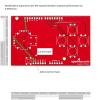Thanks alot Chris, That was the ticket! It works now. When I get to work in the morning I will get a MAC address from my allocation.klotz,
Try the following MAC address; it's an official Secret Labs MAC address (and one we use for testing).
5C-86-4A-00-00-09
Chris
Just out of curiosity, any idea why the default one in the test code would not work?







